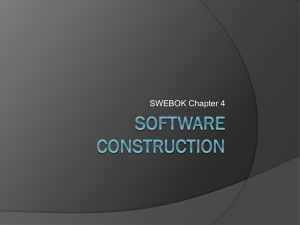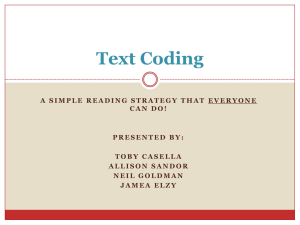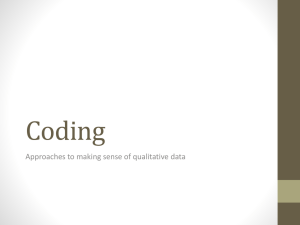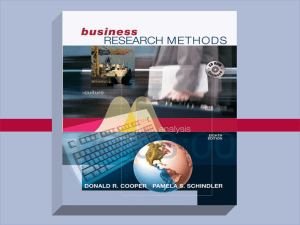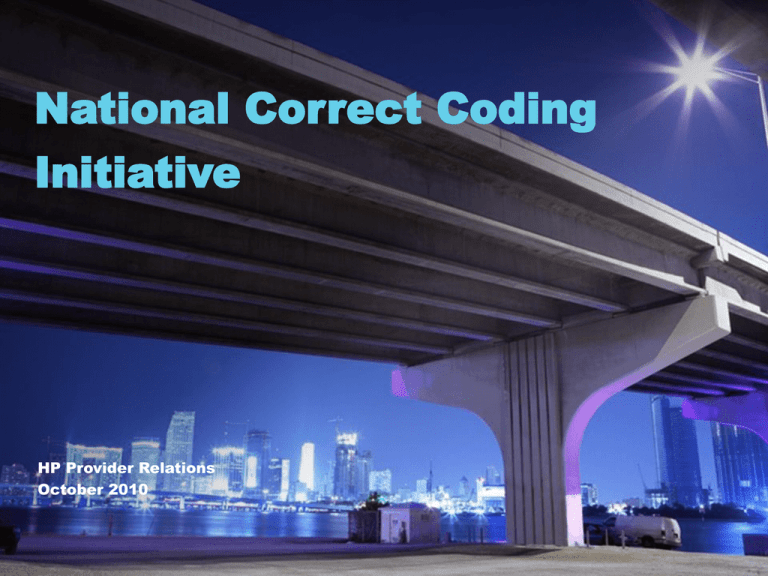
National Correct Coding
Initiative
HP Provider Relations
October 2010
Agenda
– National Correct Coding Initiative (NCCI)
– NCCI editing
– Correct use of modifiers
– Avenues of resolution
2
National Correct Coding Initiative
October 2010
Objectives
– Understand what NCCI is
– Understand who is affected and when the changes will take place
– Understand the use of modifiers
– Understand how to resolve NCCI questions
3
National Correct Coding Initiative
October 2010
Change
National Correct Coding Initiative implementation
National Correct Coding Initiative
What is it?
– In the 1990s, the Centers for Medicare & Medicaid Services (CMS)
developed the NCCI to promote national correct coding methodologies
and to control improper coding leading to inappropriate payment
– NCCI has been in place for many years and most providers are
familiar with the editing methodologies used with Medicare
– Based on input from a variety of sources:
•
American Medical Association (AMA) Current Procedural Terminology (CPT®)
guidelines
•
Coding guidelines developed by national societies
•
Analysis of standard medical and surgical practices
•
Review of current coding practices
CPT copyright 2009 American Medical Association. All rights reserved. CPT is a registered trademark of the American Medical Association.
5
National Correct Coding Initiative
October 2010
National Correct Coding Initiative
– The recent healthcare legislation passed into law (H.R. 3962), requires
that Medicaid programs incorporate compatible methodologies of the
NCCI into their claims processing system
– Section 6507 mandates that NCCI methodologies must be effective for
claims filed on or after October 1, 2010
– Initial editing will encompass three basic coding concepts:
6
•
NCCI Column I and Column II
•
Mutually Exclusive (ME) Edits
•
Medically Unlikely Edits (MUE)
National Correct Coding Initiative
October 2010
National Correct Coding Initiative
– The NCCI Policy Manual is located at
http://www.cms.gov/NationalCorrectCodInitEd/
7
National Correct Coding Initiative
October 2010
National Correct Coding Initiative
How does it work?
– NCCI editing is applied to claims reporting:
•
Same date of service
•
Same member
•
Same billing provider NPI
– Also included in NCCI editing are:
8
•
Claims with Third Party Liability (TPL) amounts
•
Claims denied by the primary insurance
National Correct Coding Initiative
October 2010
National Correct Coding Initiative
Who will be affected?
– Included in NCCI:
•
Physician claims
•
Institutional outpatient claims
•
Type of bill 13X and 83X
– Excluded from NCCI:
9
•
Medicare crossover
•
Dental
•
Home health
•
Hospice
•
Inpatient
•
Long-term care
•
Waiver
•
Pharmacy
National Correct Coding Initiative
October 2010
National Correct Coding Initiative
When is implementation?
– Professional claims – October 28, 2010
•
Includes column I/II, ME, MUE
– Healthcare reform legislation mandates NCCI methodologies must be
effective for claims filed on or after October 1, 2010
– HP will mass adjust claims received on or after October 1, 2010,
through the implementation date
10
National Correct Coding Initiative
October 2010
National Correct Coding Initiative
Institutional outpatient
– Outpatient claims targeted for
April 1, 2011
– Bill type 13X and 83X
•
Column I and Column II
•
ME
•
MUE
– HP will mass adjust claims received
on or after October 1, 2010, through
the implementation date
11
National Correct Coding Initiative
October 2010
Define
Column I/Column II, MUE, and ME
New Edits for NCCI
– New explanation of benefit (EOB) codes have been developed that
specifically identify:
•
When a claim detail has encountered an NCCI edit
•
When a claim could not process through NCCI editing for an unexpected event
– BT201036 defines these edits including:
13
•
New EOB numbers
•
EOB Descriptions
•
Purpose of EOBs
National Correct Coding Initiative
October 2010
New NCCI Edits Example
New
EOB
EOB Description
Purpose of EOB
4181
Service denied due to a National
Correct Coding Initiative (NCCI)
edit. Go to
http://www.cms.gov/NationalCorre
ctCodInitEd/ for information
regarding NCCI coding policies.
This EOB will identify when a
detail on a professional (CMS1500) claim has denied for
Column I/II and/or ME edit.
4183
Units of service on the claim
exceed the Medically Unlikely Edit
(MUE) allowed per date of service.
Go to
http://www.cms.gov/NationalCorre
ctCodInitEd/ for information
regarding maximum number of
units of service allowed for the
service billed.
This EOB will identify when the
units of service allowed on a
claim detail exceed the MUE unit
limit as defined by CMS.
14
National Correct Coding Initiative
October 2010
New NCCI Edits Example
New
EOB
EOB Description
Purpose of EOB
4185
The claim did not process
through NCCI editing. The claim
will be reprocessed or adjusted at
a later date. Please monitor
future Remittance Advice
statements for processing activity
related to this claim.
This EOB will identify when a
claim could not go through NCCI
editing due to an unexpected
event. The claim is allowed to
continue through normal
processing and will be subject to a
mass adjustment at a later to
date.
9092
The claim was subjected to NCCI This EOB will identify when a
editing methodologies.
claim has gone through NCCI
editing and did not encounter any
Column I/II, ME, or MUE edits.
15
National Correct Coding Initiative
October 2010
Column I and Column II
Define
– Column I/ Column II Procedures should be reported with the most
comprehensive CPT code that describes the services performed
– Physicians must not unbundle or report multiple Healthcare Common
Procedure Coding System (HCPCS)/CPT codes when a single
comprehensive HCPCS/CPT code describes the services that were
furnished.
16
National Correct Coding Initiative
October 2010
Column1/Column II Denial
Line # From DOS To DOS
Procedure
Code
Description
NCCI Editing
01
11/01/2010
11/01/2010
58260
Vaginal
hysterectomy
for uterus 250
grams or less
Detail is
allowed
02
11/01/2010
11/01/2010
58720
Salpingooophorectomy,
complete or
partial,
unilateral or
bilateral
Detail is denied
with edit 4181
17
National Correct Coding Initiative
October 2010
Column1/Column II Denial
Line # From DOS To DOS
Procedure
Code
Description
NCCI Editing
01
11/05/2010 11/05/2010
70110
Radiologic exam,
mandible:
complete,
minimum of four
views
Detail is
allowed
02
11/05/2010 11/05/2010
70100
Radiologic exam,
mandible; partial,
less than four
views
Detail is
denied with
edit 4181
18
National Correct Coding Initiative
October 2010
Mutually Exclusive Edits
Define
– Procedure codes that cannot be reported together because they are
mutually exclusive of each other
– Mutually exclusive procedures cannot reasonably be performed at the
same anatomic site or same patient encounter
– Two or more procedures performed during the same patient encounter
on the same date of service and same billing provider that are not
normally performed together
19
National Correct Coding Initiative
October 2010
Mutually Exclusive (ME) Edits
Line # From DOS To DOS
Procedure Description
Code
NCCI Editing
01
11/15/2010 11/15/2010 58280
Vaginal
Detail is allowed
hysterectomy;
with total or partial
vaginectomy with
repair of
enterocele
02
11/15/2010 11/15/2010 58263
Vaginal
Detail is denied
hysterectomy, for with edit 4181
uterus 250 grams
or less; with
removal of tube(s)
and/or ovary(s),
with repair of
enterocele
20
National Correct Coding Initiative
October 2010
Mutually Exclusive (ME) Edits
Line # From DOS To DOS
Procedure
Code
Description
NCCI Editing
01
11/21/2010 11/21/2010
27440
Arthroplasty,
knee, tibial
plateau
Detail is allowed
02
11/21/2010 11/21/2010
27438
Arthroplasty,
patella, with
prosthesis
Detail is denied
with edit 4181
21
National Correct Coding Initiative
October 2010
Medically Unlikely Edits (MUE)
Define
– HCPCS/CPTs have a defined unit of service for reporting purposes
– Providers that bill units of service for a HCPCS/CPT code using a
criteria that differs from the code’s defined unit of service will
experience a denial
– MUE editing is based on the units of service allowed on the claim, not
the units of service billed
22
National Correct Coding Initiative
October 2010
Medically Unlikely Edits (MUE)
Line
#
From DOS
To DOS
Procedure
Code
Description
Units of
Service
billed
01
12/11/2010
12/11/2010
99232
Subsequent 6
hospital care
for the
evaluation
and
management
of a patient,
patient is not
responding
to therapy or
has a minor
complication
NCCI
Editing
Detail is
denied with
edit 4183 –
Units of
service on
the claim
exceed the
Medically
Unlikely Edit
(MUE)
allowed per
date of
service.
**If the dates of service were consecutive, the date span should represent the appropriate ‘From
and To’ period. The MUE units allowed for this code is one per day.
23
National Correct Coding Initiative
October 2010
Exceptions
Medically Unlikely Edits (MUE)
Exceptions
To align with current IHCP policy, the following are exceptions to the
MUE unit limit:
– A4253 – Blood glucose test or reagent strips for home blood glucose
monitor, per 50 strips:
•
The MUE unit limit is two and IHCP policy allows four units (or 200 test strips) per
month
– A4259 – Lancets, per box
•
The MUE unit limit is one and IHCP policy allows two units per month
These are examples only, not a complete list of unit limitations that may exist
25
National Correct Coding Initiative
October 2010
NCCI Code Auditing
Exceptions
– Antepartum Care
•
59425 – Antepartum care only; four to six visits
•
59426 – Antepartum care only; seven or more visits
•
Billed with modifiers
− U1 – Trimester one – 0 through 14 weeks, 0 days
− U2 – Trimester two – 14 weeks, one day through 28 weeks, 0 days
− U3 – Trimester three – 28 weeks, one day, through delivery
•
And when billed on the same date of service as the lab codes listed in BT201036 will
not be subject to NCCI Column I/II editing
Chapter 8 of the IHCP Provider Manual “Obstetrical Care” section provides specific
billing information and a complete list of lab services allowed for each trimester
26
National Correct Coding Initiative
October 2010
Bill
Modifiers and date spans
Use of Modifiers
What is correct?
– Modifiers may be appended to HCPCS/CPT codes only when clinical
circumstances justify the use of the modifier
– A modifier should not be appended to a HCPCS/CPT code solely to
bypass NCCI editing
– The use of modifiers affects the accuracy of:
28
•
Claims billing
•
Reimbursement
•
NCCI editing
•
Clarification of procedures
•
Special circumstances
National Correct Coding Initiative
October 2010
Use of modifiers
– Correct use of modifiers is essential to accurate billing and
reimbursement for services provided.
– Chapter 8, Section 4 of the IHCP Provider Manual gives detailed
descriptions of modifiers
– The CMS provides carriers with guidance and instructions on the
correct coding of claims and using modifiers through manuals,
transmittals, and the CMS Web site
•
Providers can access the CMS Web site at www.cms.hhs.gov
– The National Correct Coding Initiative (NCCI) provides updates each
quarter for correct modifier usage for each CPT code
http://www.cms.gov/NationalCorrectCodInitEd/
29
National Correct Coding Initiative
October 2010
Modifier 59
Distinct procedure or service on the same day
– Should only be used when there is no other modifier to correctly clarify
the procedure or service
– A distinct procedure may represent the following:
•
Different session or patient encounter
•
Different procedure or surgery
•
Different site or organ system
•
Separate incision or excision
•
Separate lesion
•
Separate injury or area of injury in extensive injuries
– If multiple units of the same procedure are performed during the same
session, the provider should report all the units on a single detail line,
unless otherwise specified in medical policy
30
National Correct Coding Initiative
October 2010
Modifier 50
Bilateral procedure
– Bilateral procedures performed during the same operative session on
both sides of the body by the same physician
– Units billed would be entered as 1 because one procedure was
performed bilaterally
– Modifier 50 is only required when the use of 50 is mandated by
verbiage within the CPT coding manual
31
National Correct Coding Initiative
October 2010
Modifier 51
Multiple procedures
– Multiple procedures or services are performed on the same day or
during the same operative session by the same physician
– The additional or secondary procedure or service must be identified by
adding modifier 51 to the procedure or service code
32
National Correct Coding Initiative
October 2010
Modifiers LT and RT
Procedures that can be performed on paired organs
– Identifies procedures that can be performed on paired organs such as
ears, eyes, nostrils, kidneys, lungs, and ovaries
– Should be used whenever a procedure is performed on only one side
to identify which one of the paired organs was operated on
– CMS requires these modifiers whenever appropriate
33
National Correct Coding Initiative
October 2010
Span Dates
CMS-1500
– Providers must be sure to complete the “From” and “To” dates on all
claims even if the service was for one single date of service
– Services within the same calendar month and in a consecutive day
pattern, must be billed with the appropriate units of service and
“From” and “To” dates
– Failure to report the correct date span and the number of units
performed during the date span could result in a claim denial
34
National Correct Coding Initiative
October 2010
Span Dates
Example
From DOS
To DOS
Procedure Code Description
Units of Service
10/03/2010
10/07/2010
E0202
5
Phototherapy
– Detail is allowed and does not encounter NCCI edits.
35
National Correct Coding Initiative
October 2010
Web interChange
Processing expectations
– Claims are usually viewable within two hours via the Claim Inquiry
function
– On rare occasions, claims will not be available for viewing within the
usual two-hour time frame
– If the delay is longer than 24 hours, providers may contact HP
Customer Assistance to determine the reason for the delay
36
•
1-800-577-1278, or
•
(317) 655-3240 in the Indianapolis local area
National Correct Coding Initiative
October 2010
Inquire
Avenues of resolution
Claims Denials/Inquiry
– Follow normal avenues of resolutions
– IHCP Web site at www.indianamedicaid.com
– Customer Assistance
•
1-800-577-1278, or
•
(317) 655-3240 in the Indianapolis local area
– Written Correspondence
•
Written Correspondence
P.O. Box 7263
Indianapolis, IN 46207-7263
– Provider relations field consultant
38
National Correct Coding Initiative
October 2010
Claims Denials/Inquiry
New options
– New options
39
•
http://www.cms.gov/NationalCorrectCodInitEd – Column I and II, Mutually Exclusive
(ME), and Medically Unlikely Edit files. These files contain specific code pairs for
Column I /II and the Mutually Exclusive edits.
•
Administrative review
National Correct Coding Initiative
October 2010
Administrative Review
Requirements
– Administrative review must be requested within seven days of
notification of claims payment or denial
•
Used when there are unusual circumstances in which a provider believes the claim
was coded correctly and would like reconsideration of the NCCI editing
– Complete an IHCP Programs Inquiry form or write a letter stating:
•
Reason for disagreement
•
Denial or amount of reimbursement
•
Clearly note “Administrative Review” on the form or letter
•
Attach all pertinent documentation
•
Add “Attention To: Health Care Administrative Review Specialist”
– The IHCP Programs Inquiry form can be obtained from the Indiana
Medicaid Web site in the forms section at www.indianamedicaid.com
40
National Correct Coding Initiative
October 2010
Administrative Review
Address
– Send forms or letters to:
•
41
Attn: Healthcare Administrative Review Specialist
Written Correspondence
P. O. Box 7263
Indianapolis, IN 46207-7263
National Correct Coding Initiative
October 2010
Contact
Concerns about Specific NCCI Edits?
For NCCI information only
– Submit comments in writing to:
•
National Correct Coding Initiative
Correct Coding Solutions, LLC
P.O. Box 907
Carmel, IN 46082-0907
– Send to the attention of Niles R. Rosen, M.D., Medical Director and
Linda S. Dietz, RHIA, CCS, CCS-P, Coding Specialist
– Send questions regarding NCCI table edits only; do not send claims
questions or claim appeals
43
National Correct Coding Initiative
October 2010
Questions




